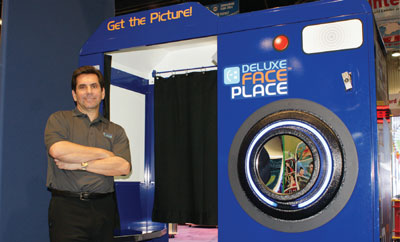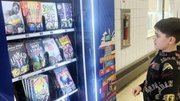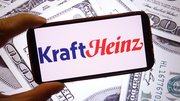News
Apple Industries Founder Foresees Photobooth Integration Into Vending
February 9, 2016 | Nick Montano
TAGS: photo booth, Face Place photobooth, Apple Industries, up-sell merchandising, product fulfillment, retail kiosk, Allen Weisberg, Apple Amusement Vending, vending machine, vending operator, automatic imaging products Anatol Josepho, Photomaton, photo booth history, photo booth trends, photo booth market size, micromarket stores, coin machine |
Upsell merchandising could promote broad appeal to millennial patrons and beyond
GREENVALE, NY -- Eight years ago, a second-generation coin machine operator from New York City purchased the assets of a distressed photobooth manufacturer. Allen Weisberg, who operated Bronx-based Apple Amusement Vending, had been involved in developing and marketing automatic imaging products since the late 1990s.
But his 2008 purchase of Face Place, which manufactured a photobooth of the same name under a license from Polaroid, began a tactical odyssey whose impact on the digital photobooth is as significant as Anatol Josepho's Photomaton in 1925.
The Face Place of 10 years ago only allowed customers to buy a strip of four different black and white photographs, each 2" square, similar in look and feel to the classic "four-for-a-quarter" photobooths of the 1950s. But under his direction, Weisberg's photobooth manufacturing company -- Apple Industries Inc. -- advanced the Face Place at an unexpected rate. Color output, new size formats and improved print quality were added immediately, with Internet and social media integration following three years later.
 |
WORTH A THOUSAND WORDS:Apple Industries founder and chief executive Allen Weisberg is pictured here with the Face Place Deluxe, the company's signature photobooth. Designed to look like a giant camera, this model is Apple's largest enclosed booth. Weisberg describes the photobooth as the "ultimate" vending machine: it finishes a high-profit product from basic ingredients (paper) without any waste. Incremental upsell options continue to grow on the Face Place network. |
With roots planted in music and games -- his father Abraham was a jukebox technician who became an operator -- marketing a new photobooth to the amusement industry was a natural fit for Weisberg. And Apple Industries, which moved from the Bronx to Greenvale, NY, is enjoying ongoing success selling to street operations and site-based entertainment centers, and by some estimates now commands more than half the market in the United States. The entrepreneur believes that the photobooth's next big opportunity could be in the hands of merchandise vending operators. Why, where and how this is going to happen is mostly conjecture at this point, but Weisberg is confident that the latest Face Place photobooths possess compelling features that could complement food and beverage vending operations in many contemporary location types.
Editor's Note | FLASHBACK:The concept of a coin-operated photobooth with a curtain originated with Anatol Josepho, who emigrated to the U.S. from Russia in 1923. He invented and patented the first photobooth in 1925, named it Photomaton and sold rights to it for $1 million in 1928. The first Photomaton was placed on Broadway (in an attended location billed as a portrait studio) in Manhattan in 1927. For 25¢, it took, developed and printed eight photos, a process taking 10 minutes. About 280,000 people reportedly used it during its first six months of operation.
"We have two main customers," Weisberg said. "The trade, which consists of our distributors and operators; and the end users, who are mostly millennials and females."
Millennials -- young adults who are currently between ages 18 and 34 -- wield $1.3 trillion in annual buying power. That's certainly enough to prompt any vending operator take notice. U.S. millennials are diverse; some 43% are nonwhite and about 25% speak a language other than English at home.
In 2011, research conducted by the National Automatic Merchandising Association found that more than 85% of consumers between the ages of 18 and 29 (the millennial age range then) would choose a vending machine over other retail options. "Millennials love novelty and the interactivity of the photobooth," Weisberg noted. "They can add graphics, share their pictures, email them and upload to social media. The photobooth is an effective way for vending operators to reach this visually oriented demographic."
The "upsell" factor is a key indicator of Face Place's success as a merchandise vending machine. While the food and beverage segment has recently developed and begun deploying technology to allow patrons to "shop" machines and purchase more than one item in a single transaction (a 20-fl.oz. cold drink and bag of chips, for instance), secondary purchases on Face Place machines already represent 30% or more of all revenue generated by photobooths. A Face Place purchase starts out with a photo strip of four poses printed and dispensed as two four-frame sets. Additional prints in 4x6 sizes, video messaging and social media uploads are standard upsell options. Some operators do not charge for social media transfers, while others have charged $1 for that option.
"Bar operators have succeeded with upsell features, and I believe that operators providing food and drink vending services in public locations also can take advantage of what our photobooths have to offer," Weisberg said. "There could even be some opportunities in business and industry settings, and a photobooth surely would be a great adjunct at self-checkout micromarket stores."
Apple's latest upsell option will enable vending operators to participate in the Internet retailing space. This quarter, the manufacturer is rolling out its personalized product fulfillment program, which allows patrons to purchase merchandise imprinted with the images of their choice.
The merchandise option is expected to create a new stream of revenue when customers take their photos, then order products emblazoned with those images. Coffee mugs, keychains, thermos bottles, tote bags, iPhone cases and picture frames are among the items that can be personalized and ordered at Face Place photobooths.
Customers who pay the standard vend price for their print photos can then choose to take advantage of one or all of the upsells, including enlargements or additional prints; instant electronic posting to social media like Facebook, Twitter and now Instagram; and -- with the addition of fulfillment upgrade -- products customized with their own photos, taken and ordered immediately right in the booth. Suggested vend prices for photo-customized products are in the $20 and up range, giving operators significant profit margins on $5 to $7 wholesale costs per item. Products will be created and shipped on the same day they're ordered.
 |
ORDER FULFILLMENT:Display case shows off merchandise examples available from Face Place's product fulfillment lineup. A free software upgrade for Face Place photobooths that run on Apple Industries' Smile 2.0 operating system will allow patrons to purchase coffee mugs, keychains, thermos bottles, tote bags, iPhone cases and picture frames, among other items, personalized with their images. Orders are processed at photobooths. Product fulfillment begins at Face Place photobooths in Q1. |
"Our fulfillment service is right in step with today's 'gotta-have-it-now' culture," Weisberg said. Customers can select their desired shipping speed, including overnight service at extra cost.
The new product fulfillment service will be supported by an email marketing program. On key occasions like the Christmas season and other holidays, Face Place customers will receive reminders that photo-customized products make great gifts. "If 10% of Face Place customers order a photo-customized product, it will double the profitability of a photobooth," Weisberg said.
While product fulfillment opportunities, proven upselling strategies and millennial appeal are some of Weisberg's arguments for why vending operators should consider adding photobooths to their offerings, answering the question of where to place them might not be as obvious. Photobooths have become staples in retail venues, amusement and bowling centers, movie theaters, amusement parks, museums and zoos, among other attraction, recreation and tourist destinations. But they've also found their way into street locations, notably taverns, thanks in no small part to Apple Industries. For vending operators, Weisberg sees potential in hospitals, hotels, college and university campuses, transportation depots, and other public and institutional sites.
The manufacturer's weather-resistant outdoor model was developed with vending operators in mind. Weatherized and fortified, Apple's outdoor booth, introduced four years ago as the Face Place Theme Park Edition, can withstand the elements so operators can provide the same features found in the manufacturer's indoor models. It is made of powder-coated steel, treated to resist rain, wind and variable temperatures, and is equipped with a water-resistant bill validator and credit card reader, too. Other components, like the booth's 32"outer display monitor and curtain, are weather-resistant. It has lockable wheels that permit moving it into a shelter at night, or relocating off season. It measures 70" long x 36" wide by 83" high, and weighs 875 lbs.
"Outdoor photo vending is an area where I'd like to work with vending operators," Weisberg said. "We're seeing strong numbers with these booths, which we often customize for our clients."
Not surprisingly, Weisberg says Apple Industries' photobooths are the best match for full-line vending operations. The lifeÂspan of the typical Face Place unit, which costs almost twice as much as the standard snack or cold drink machine, is 13 years, he observed. Face Place's durability and lifecycle earning, along with its consumer-facing "shopping" features, is Weisberg's answer to how vending operators can enter the photobooth business.
"When investing in a photobooth, operators first need to consider earnings' longevity and cabinet durability," he explained. A photobooth should be made of all-steel components, with a rustproof exterior and rugged interior floor, usually formed of stainless-steel diamond plate. None of Apple's booths uses wood components, and Weisberg dismisses any photobooth cabinet that employs T-molding. Face Place booths are assembled in Bath, NY, by the same fabricator that used to make AT&T's classic phonebooths.
The photobooth's main modules are the computer, monitor, camera and printer; Face Place machines use Mitsubishi dye-sublimation printing systems. In 2011, Apple introduced its Smile 2.0 operating system, which has been supported by numerous updates, most recently product fulfillment. These updates are free.
Picture quality matters, too. "What makes a good photo? It's software," Weisberg observed. "The combination of software and lighting is more important than the camera. Great and consistent picture quality must be there because potential customers will look at the print and judge it." In 2014, Apple was able to upgrade its default vend price, for its standard two print output, to $5 from $3 because of its photo quality. The operator's cost per sheet is 59¢.
The American digital photobooth market is still in its latest expansion phase, according to Weisberg. Several knowledgeable industry observers estimate that there could as many as 20,000 photobooths in operation today, and more than half of those might be Face Place products. There are several players competing in the space. Innovative Foto Inc., formally Fantasy Entertainment, which is primarily an operator, claims to have about 3,000 units in North America. Founded in 1995 in Salem, NH, Innovative Foto was acquired in December 2014 by DNP Imagingcomm America, a subsidiary of Japan's Dai Nippon Printing Co., a manufacturer of dye-sub media. Various game manufacturers, including LAI Games, Sega, Smart Industries and Team Play, offer photo-vending systems primarily for the amusement market. And there are more than a dozen niche photobooth makers at any one time, many trying to capitalize the genre's popularity in the special events rental space, that offer a machine. International firms, including Spain's Digital Centre, market photobooths in the U.S.
Photobooths have been more prevalent in Europe, where they are mostly used as a utility for passport photos, as well as IDs for licenses, applications and contracts. (In the U.S., photobooths are pure entertainment.) England's Photo-Me International, with 25,000 installed units worldwide, is the largest operator of photobooths in Europe and the UK. It also has machines in Indonesia, Japan and Philippines.
Weisberg had his first serious look at the photobooth business as a young boy when he met Albert Simon, a 10th Ave. distributor, in the early 1970s. Simon had begun to build automatic picture machines during the Great Depression and ran Auto-Photo Co., the nation's dominant photobooth company in the 1940s through the 1960s. Auto-Photo rented its wet-process machines to locations, famously cutting exclusive deals with the F.W. Worlworth Co. and S.S. Kresge Co., which allowed it to generate revenue through long-term operations rather than equipment sales.
"Al Simon's business was about selling photobooth supplies," Weisberg said. "He built machines and owned them during their operational life, and sold supplies to his locations. That's how he recovered the cost of the machine. Similarly, Apple is the exclusive supplier of its media supplies, but we sell our machines to operators."
Apple's media sales are a big part of its revenue stream. It ships a dye-sub ink cartridge with every Face Place paper roll, which yields 600 vends ($3,000). Since the introduction of the Smile 2.0 platform in 2011, the company's machines have printed almost 50 million photo strips.
Today's consumers have an entirely new relationship with imaging that can be difficult for the older generation to grasp. Smartphones have made it practical to make spur-of-the-moment self-portraits that were impractical even for instant-film cameras, and their young users enjoy transmitting these "selfies" to social media sites, which they also follow to see their coevals' pictures. A modern online photobooth therefore appeals strongly to them, since its picture quality is superior (at least in terms of lighting and composition), and the booth can offer enhancements.
Had anyone told vending operators four decades ago that their growth product categories would include all-natural organic snacks and bottles of water, they would not have believed it. Weisberg contends that a similar transformation of consumer desire is now underway, and merchandise vending operators who are prepared to suspend their disbelief and simply try photobooths will find a whole new market opening up to them.
 |
LINEUP:Apple offers 11 Face Place photobooth models. Five ideal for the vending trade, from left, are Ruby, Sapphire, Theme Park, Scene Machine and Photo2Go. The Face Place Scene Machine employs green screen technology to place users into a "scene" of their choice. |







